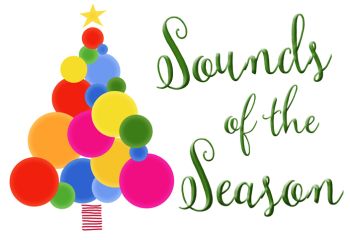Sounds of the Season: 12•17•17
A Christmas Festival, by Leroy Anderson
Composed by Leroy Anderson (1908–1975) in 1950, “A Christmas Festival” is an overture built on traditional holiday songs. Performed frequently by both wind and string ensembles, this piece is a prime example of the kind of music for which Anderson became famous. Many of Anderson’s works were premiered by the Boston Pops Orchestra under the direction of Arthur Fiedler. Fiedler’s successor, composer and conductor John Williams, described Anderson as “one of the great American masters of light orchestral music.”
Sleepers, Awake!, by J. S. Bach (arr. Alfred Reed)
Johann Sebastian Bach (1685–1750) based the text and music for “Sleepers, Awake!” on a Lutheran chorale. He composed two versions: a cantata in 1731 and an organ prelude in 1746. The hymn became well known among U.S. audiences after it was recorded by the Philadelphia Orchestra under the direction of Eugene Ormandy. The poignant work was arranged for concert band by Alfred Reed (1921–2005), one of the United States’ most prolific composers and arrangers.
Fantasia on the “Dargason,” from Second Suite in F, by Gustav Holst
Gustav Holst (1874–1934) is best known for his seven-movement orchestral suite The Planets, but he also composed many other works across a range of genres, including voice and military band. His First Suite in E-flat and Second Suite in F, composed in 1909 and 1911, respectively, are considered among the first serious works for band and remain part of the standard repertoire. “Fantasia on the ‘Dargason,’” the final movement of Holst’s Second Suite, is based on two tunes from The Dancing Master, a 1651 manual of English country dancing. The movement begins with the first tune, “Dargason,” which forms the basis of the fantasia: a free-form and often improvisational type of composition. The second tune, “Greensleeves,” is cleverly woven into the fantasia.
A Winter’s Night, by Josef Mohr and Franz X. Gruber (arr. Rick Kirby)
Composer and arranger Rick Kirby (b. 1945) based “A Winter’s Night” on the beloved Christmas carol “Silent Night.” Composed in 1811, the carol resulted from the collaboration of two good friends: Josef Mohr (1792–1848), a priest at a small Catholic church in Austria, and Franz Xaver Gruber (1787–1863), the church organist. On Christmas Eve Day, Mohr was inspired to ask Gruber to compose a melody for his lyrics, which were based on a poem he had written about the night Jesus was born. Gruber faced a challenge because the church’s organ was not working, but within only a few hours, he finished the piece. He wrote a melody that could be sung with guitar, and the two friends performed their new composition, “Stille Nacht,” at the church service that evening.
Variants on a Mediaeval Tune, by Norman Dello Joio
Norman Dello Joio (1913–2008) was only 14 when he began his musical career as a church organist and choir director in New York. His grandfather and father were both accomplished organists, and he grew up surrounded by music and musicians. Dello Joio studied at Juilliard and later taught at Sarah Lawrence, Mannes College of Music, and Boston University. Encouraged by composer Paul Hindemith to develop his own natural compositional style, Dello Joio went on to write works across a wide range of genres—from chamber pieces to ballets and operas to scores for television programs. He wrote Variants on a Mediaeval Tune after receiving a commission from the Mary Duke Biddle Foundation; the piece was premiered in April 1963 by the Duke University Band. The theme of the piece is “In Dulci Jubilo” (“In Sweet Rejoicing”), a traditional Christmas carol from the Middle Ages. The theme is presented in a brief introduction and then developed in five dramatically different variants. Many composers have based works on “In Dulci Jubilo”—among them, J. S. Bach, who arranged the melody for both choir and organ and also included it in other compositions.
Intermission
The Night Before Christmas, by Randol A. Bass
The poem “A Visit from St. Nicholas,” more commonly known as “The Night Before Christmas,” is attributed to Clement Clarke Moore (1779–1863). The verse was first published anonymously on December 22, 1823, in the Troy, New York, newspaper, and it was reprinted for several years before Moore claimed authorship. Moore’s verse—one of the most popular of all American poems—is considered to be the origin of the modern notion of Santa Claus. This musical version of the poem, by Randol A. Bass (b. 1953), was commissioned in 1988 by the Cleveland Symphony.
Tom Hegg, Guest Narrator
The Christmas Song, by Mel Tormé and Robert Wells (arr. John Cacavas)
A holiday favorite, “The Christmas Song” was composed in 1944 in a collaboration between Mel Tormé (1925–1999) and Robert Wells (1922–1998). The duo reportedly wrote the piece in just 40 minutes on a sweltering summer day. Wells, best known as a lyricist, thought that he would “stay cool by thinking cool.” “The Christmas Song” is one of the most often performed holiday pieces; it has been recorded more than 1,700 times.
O Come, All Ye Faithful, Traditional (arr. Stan Bann)
“O Come, All Ye Faithful” has been attributed to several composers from the fifteenth and sixteenth centuries. It was first published in 1751 in the collection Cantus Diversi, by John Francis Wade (1711–1786). The four original verses were written in Latin (“Adeste Fideles”), most likely by an order of monks. The most widely used English text was translated by an English Catholic priest, Frederick Oakeley (1802–1880). Today’s setting of the piece for brass was created by Stan Bann, a long-time Medalist member and Twin Cities composer, arranger, performer, and educator.
Christmas Time Is Here, by Vince Guaraldi (arr. Stan Bann)
Vince Guaraldi (1928–1976), a jazz pianist and composer, wrote the musical scores for all 16 Peanuts television specials. The first song Guaraldi wrote for the Peanuts series was “Linus and Lucy,” which later became the signature theme of all the specials. Guaraldi composed “Christmas Time Is Here” in 1965 for A Charlie Brown Christmas. This arrangement of the modern Christmas classic is by Stan Bann.
White Christmas, by Irving Berlin (arr. Zane Van Auken)
Several stories are told about how Irving Berlin (1888–1989) came to write “White Christmas,” a nostalgic tune that reminisces about an old-fashioned Christmas. According to one of the tales, Berlin wrote the piece in 1940 while sitting poolside at the Biltmore Hotel in Phoenix, Arizona. “White Christmas” was introduced in the 1942 film Holiday Inn and won the Oscar for “Best Song” that year. Today, the piece is considered the most often performed of all holiday songs.
Winter Wonderland, by Felix Bernard and Dick Smith (arr. Paul Lavender)
“Winter Wonderland” was written by composer Felix Bernard (1897–1944) and lyricist Richard Smith (1901–1934), both of whom were from snowy Pennsylvania. Released in 1934, the piece was first recorded by Richard Himber and the Ritz-Carlton Hotel Orchestra. It became a hit, however, when it was recorded later that year by Guy Lombardo’s orchestra, and since then, it has been recorded by more than 150 artists.
Minor Alterations: Christmas Through the Looking Glass, by David Lovrien
Composer David Lovrien (b. 1963) morphs more than eight favorite holiday tunes, from Deck the Halls to The Nutcracker Suite, into something new and inventive—a little darker than most holiday music, perhaps, but still familiar and full of wonder. By transposing the tunes from major keys to minor keys, changing styles, and overlapping melodies, Lovrien gives each carol a completely new character. Alternately dramatic and funny, wistful and energetic, this medley is full of musical surprises from start to finish. How many Christmas carols can you identify in this piece?
Sleigh Ride, by Leroy Anderson
This holiday tune by Leroy Anderson (1908–1975) is perhaps his most well known. The idea for the composition came to Anderson during a heat wave in 1947, and he completed the piece in February 1948. A year later, Arthur Fiedler and the Boston Pops Orchestra first recorded the orchestral version, and it became an immediate hit. ASCAP reports that “Sleigh Ride” consistently makes the top-10 list of most-performed music worldwide during the Christmas season.
Program notes by Susan Freese
Upcoming Performances
Join our mailing list
Subscribe to our email newsletter to learn about upcoming concerts.


